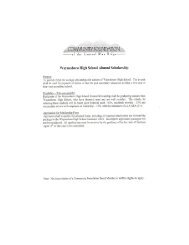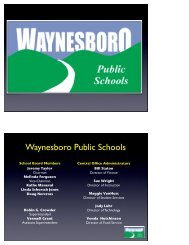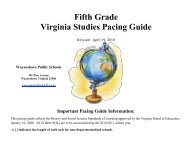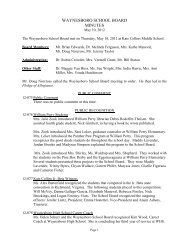Second Grade Reading Pacing Guide - Waynesboro Public Schools
Second Grade Reading Pacing Guide - Waynesboro Public Schools
Second Grade Reading Pacing Guide - Waynesboro Public Schools
You also want an ePaper? Increase the reach of your titles
YUMPU automatically turns print PDFs into web optimized ePapers that Google loves.
text across the content areas. develop vocabulary (e.g., closely<br />
related adjectives such as slender,<br />
thin, scrawny; closely related verbs<br />
such as look, peek, glance).<br />
2.8 The student will read and demonstrate comprehension of fictional texts.<br />
a) Make and confirm predictions.<br />
c) Ask and answer questions about what is read.<br />
e) Describe important events in fiction.<br />
f) Identify the problem and solution.<br />
g) Identify the main idea.<br />
UNDERSTANDING THE STANDARD<br />
(Background Information for<br />
Instructor Use Only)<br />
• Students will demonstrate<br />
comprehension of story elements in<br />
fiction by identifying the characters,<br />
setting, and main idea.<br />
• The main idea is the most important<br />
idea from the paragraph or story.<br />
• Teachers should provide<br />
opportunities for students to respond<br />
in writing to what is read.<br />
ESSENTIAL UNDERSTANDINGS<br />
All students should:<br />
• understand that comprehension<br />
requires making, confirming and<br />
revising predictions.<br />
• understand that they must attend to the<br />
details of the text in order to<br />
comprehend.<br />
ESSENTIAL KNOWLEDGE AND SKILLS<br />
To be successful with this standard,<br />
students are expected to:<br />
• identify the problems and solutions<br />
in stories.<br />
• describe the important events of a<br />
story.<br />
• use information from illustrations<br />
and words to demonstrate<br />
comprehension of plots.<br />
• describe how characters in a story<br />
respond to key events.<br />
• ask and answer simple who, what,<br />
when, where, why, and how<br />
questions to demonstrate<br />
understanding of main details and<br />
events in text.<br />
• determine the main idea or theme of<br />
paragraphs or stories.<br />
• apply knowledge of story structure to<br />
predict what will happen next (e.g.,<br />
beginning/middle/end,<br />
20









